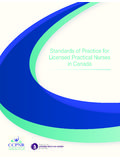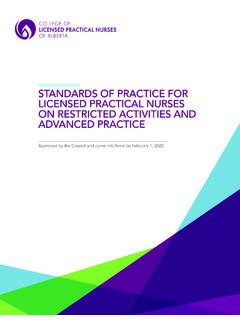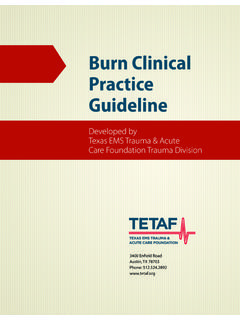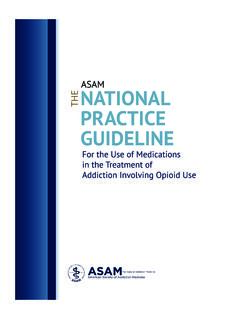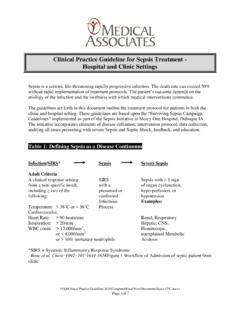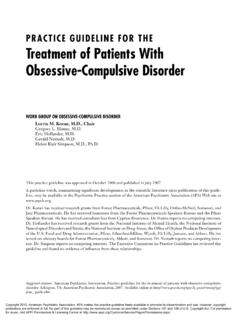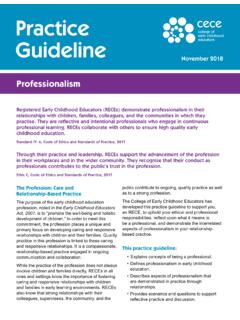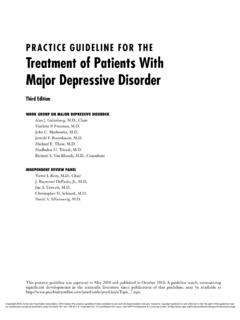Transcription of Practice Guideline - College of Licensed Practical Nurses ...
1 1 The legislative mandate of the College of Licensed Practical Nurses of alberta (CLPNA) is to serve and protect the public by ensuring its members deliver safe, competent and ethical nursing care. Practice guidelines provide guidance in a particular aspect of clinical care provision that enables Licensed Practical Nurses (LPNs) to make informed decisions based on the best available evidence. These guidelines support nursing judgment and help LPNs meet expectations of professional behaviour and requirements for Practice as set out in legislation, regulation, Standards of Practice , Code of Ethics, and Practice Policies.
2 Practice Guideline MEDICATION MANAGEMENT College of Licensed Practical Nurses of alberta Approved: June 2018 2 Table of Contents Introduction .. 5 The LPN s Role in Medication Management .. 5 Authorization for Medication Administration .. 6 Federal and Provincial Legislation .. 6 Medical Assistance in Dying (MAID) .. 7 Renal Dialysis & 7 LPN Profession Specific Documents .. 8 Employer Policies .. 8 Individual Competence .. 8 Medication Orders .. 9 Authorized Prescriber .. 9 Components of a Routine Medication Order .. 9 Abbreviations .. 9 Orders transmitted via technology .. 10 Verbal and Telephone Orders.
3 10 Intermediaries .. 11 Order Sets .. 12 Protocols .. 13 Protocols for Schedule 1 Drugs .. 13 Emergency 13 Medication Rights & Checks .. 14 Right Reason .. 14 Right Client .. 14 Right Medication .. 14 Right Dose .. 14 Right Route .. 15 Administration by Other Delivery Devices .. 15 Right Time and Frequency .. 15 Right to Refuse (and Right to Know) .. 15 Right Documentation (and Right Evaluation) .. 16 Checks .. 16 Check 1: .. 16 Check 2: .. 16 3 Check 3: .. 16 High-Alert Medications & Independent Double Checks .. 16 Medication Reconciliation .. 17 Steps to Medication Reconciliation .. 17 Medication Preparation .. 17 Preparing Medications from Ward 18 Mixing Medications.
4 18 Pre-Pouring Medication .. 19 Pass and Bridge Medications .. 19 Sample Medication .. 19 Range Doses .. 19 Sliding Scales .. 20 PRN Orders .. 21 Administration and Management of Controlled Drugs and Substances .. 21 Administration and Documentation of Narcotics .. 21 Cannabis for Medical Purposes .. 21 Naloxone .. 22 Off-Label Use of Medication .. 22 Medication Administration for the Purpose of Research .. 23 Medication Administration for Aesthetic Purposes .. 24 Administration of Complementary and/or Alternative Therapies .. 24 Immunization and Vaccine Administration .. 25 Allergy Testing and Desensitizing Injections (Immunotherapy).
5 25 Evaluating Client Outcomes .. 26 Documentation .. 26 Medication Administration Record (MAR) .. 27 Storage, Disposal and Transportation of Medication .. 27 Disposal of Controlled Drugs and Substances .. 27 Over-the-Counter Medications .. 27 Client s Own Medication .. 28 Self-Administration .. 28 Acute Care and Continuing Care Facilities .. 28 Home Care and Supportive Living Settings .. 29 Supervision and Assignment of Components of Medication Administration to Health Care Aides .. 29 Assigning Assistance with PRN Medications .. 30 4 Assigning Assistance with Insulin Administration .. 30 Supervising a Practical nurse Student Assigned to Perform a Restricted Activity.
6 30 Co-Signing for Students .. 31 Medication Safety .. 31 Safety and Infection Prevention and Control .. 31 Hazardous Medications .. 31 Strategies to Reduce Medication Errors and Adverse Events .. 32 Reporting Adverse Events, Medication Errors or Near Misses .. 32 Conclusion .. 33 Glossary .. 34 References .. 37 5 Introduction The College of Licensed Practical Nurses of alberta (CLPNA) has a mandate to ensure Licensed Practical nurse (LPN) services in alberta are provided in a manner that protects and serves the public through excellence in Practical nursing. The purpose of this Medication Management Guideline is to provide guidance to LPNs by enhancing the understanding of the LPN role and expected practices in medication management.
7 guidelines are not intended to be exhaustive but to provide guidance in making informed decisions. The Canadian Patient Safety Institute defines medication management as client-centered care optimizing safe, effective and appropriate drug therapy provided in collaboration with clients and their health care team(s).1 This Guideline refers to the assessment, planning, preparation, implementation, administration, evaluation and documentation required in the management of medication. The Guideline is based on federal and provincial legislation, the professional Standards of Practice and Code of Ethics adopted by the CLPNA, and the Competency Profile for It is also informed by Accreditation Canada s Medication Management Standards, guidelines provided by the Institute for Safe Medication practices and the Canadian Patient Safety Institute, and the work of other nurse regulators across The LPN s Role in Medication Management Medication administration must be performed in accordance with legislation, regulatory standards and policy documents, and employer policy.
8 The LPN may administer medication4 under the following conditions: The LPN must have the education, knowledge, and competence to accept and transcribe medication orders according to best Practice ; The LPN must have the education, knowledge, and competence to safely prepare, initiate, administer, monitor, titrate, and discontinue medications ; 1 Canadian Patient Safety Institute (CPSI), Medication Management, (2016), 2 Canadian Council for Practical nurse Regulators (CCPNR), Code of Ethics for Licensed Practical Nurses in Canada (2013) ; CCPNR, Standards of Practice of Licensed Practical Nurses in Canada (2013), ; College of Licensed Practical Nurses of alberta (CLPNA), Competency Profile for Licensed Practical Nurses (April 2015), 3 Accreditation Canada, Medication management standards (April 2016).
9 4 All bolded text is defined in the Glossary located at the end of this Guideline . 6 The LPN must adhere to the core rights and checks of medication administration to ensure client safety; and The LPN s decision to administer medications must always include the client's individual needs determined through health assessment, the LPN's competence and the availability of supports in the Practice environment to ensure safe medication administration. Authorization for Medication Administration Federal and Provincial Legislation Drugs in Canada are controlled at a federal level by the Food and Drug Act, the Controlled Drugs and Substances Act and the regulations associated with those Acts including the Natural Health Products Regulations.
10 In Canada drugs are categorized into three schedules, or four categories: 1. Schedule 1 drugs require a prescription as a condition of sale. 2. Schedule 2 drugs are available without a prescription but must be obtained from a pharmacist. 3. Schedule 3 drugs are available without a prescription from the self-selection area of a pharmacy. 4. Unscheduled drugs are not listed in a National or Provincial schedule and may be sold from any retail The National Association of Pharmacy Regulatory Authorities maintains an online database of the National Drug Schedules available at alberta s provincial drug schedules are generally aligned with the National Drug Schedules.
